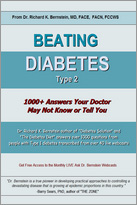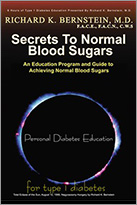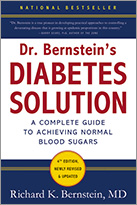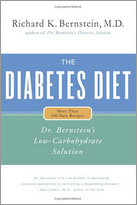NO-NO FOODS: ELIMINATING SIMPLE SUGARS
Named below are some of the common foods that contain simple sugars, which rapidly raise blood sugar or otherwise hinder blood sugar control and should be eliminated from your diet. All grain products, for example—from the flour in “sugar-free” cookies to pasta to wheat or non-wheat grain products except pure bran—are converted so rapidly into glucose by the enzymes in saliva and further down in the digestive tract that they are, as far as blood sugar is concerned, essentially no different than table sugar. There are plenty of food products, however, that contain such tiny amounts of simple sugars that they will have a negligible effect on your blood sugar. One gram of carbohydrate will not raise blood sugar more than 5 mg/dl for most diabetic adults (but considerably more for small children). A single stick of chewing gum or a single tablespoon of salad dressing made with only 1 gram of sugar certainly poses no problems. In these areas, you have to use your judgment and your blood sugar profiles. If you’re the type who, once you start chewing gum, has to have a new stick every 5 minutes, then you should probably avoid chewing gum. If you have delayed stomach-emptying (Chapter 22), small amounts of “sugar-free” chewing gum may help facilitate your digestion.
Powdered Artificial Sweeteners
At this writing, several artificial sweeteners are available. They are available from different manufacturers under different names, and some, such as Equal and Sweet’n Low, can have brand names under which more than one form of sweetener is sold. Here, to simplify your shopping, are acceptable products currently and soon to be available:
saccharin tablets or liquid (Sweet’n Low)
aspartame tablets (Equal, NutraSweet)*
acesulfame-K (Sunette, The Sweet One)
stevia powder or liquid (stevia has not been approved in the European Union)
sucralose tablets (Splenda)
neotame (newly approved by the FDA)
cyclamate tablets and liquid (not yet available in the United States)
* Many Web sites falsely perpetuate the myth that aspartame is toxic because its metabolism produces the poison methanol. In reality, one 12-ounce can of an aspartame-sweetened soft drink generates only ½5 as much methanol as does a glass of milk.
These are all noncarbohydrate sweeteners that vary in their availability and can be used to satisfy a sweet tooth without, for the most part, affecting blood sugars. But when sold in powdered form, under such brand names as Sweet’n Low, Equal, The Sweet One, Sunette, Sugar Twin, Splenda, and others, these products usually contain a sugar to increase bulk, and will rapidly raise blood sugar. They are all orders of magnitude sweeter tasting than sugar. So when you buy them in packets
and powdered form, with the exception of stevia, they usually contain about 96 percent glucose or maltodextrin and about 4 percent artificial sweetener. If you read the “Nutrition Facts” label on Splenda, for example, it lists, as such labels must, ingredients in order from most to least: dextrose (glucose), maltodextrin (a mixture of sugars), and finally sucralose.
Most powdered sweeteners are sold as low-calorie and/or sugar-free sweeteners because they contain only 1 gram of a sugar as compared to 3 grams of sucrose in a similar paper packet labeled “sugar.” More suitable for diabetics are tablet sweeteners such as saccharin, cyclamate, and aspartame. As noted above, the same brand name can denote multiple products: Equal is a powder containing 96 percent glucose and also a tablet containing a minuscule (acceptable) amount of lactose. Sweet’n Low powder is saccharin with 96 percent glucose. Stevia powder and liquid (sold in health food stores) contain no sugar of any kind and only minute amounts of carbohydrate.
A new “natural artificial” sweetener, called tagatose (no brand name as of this writing), has been approved for sale in the United States. Derived from milk, it’s claimed to be 92 percent as sweet as sugar, with no aftertaste and no effect on blood sugars. This last claim—that it has no effect on blood sugars—remains to be seen. In many cases, what’s termed “no effect” or “negligible effect” usually has significant enough effect to make blood sugar control difficult.
Another new artificial sweetener, neotame, is being sold as an additive by the makers of NutraSweet. It is supposedly 8,000 times as sweet as table sugar. Its use as a food additive should pose no problems, but if it becomes available to consumers as a powder, it will probably be mixed with a sugar as in the instances cited above.
So-Called Diet Foods and Sugar-Free Foods
Because U.S. food-labeling laws in the recent past have permitted and thus encouraged products to be called “sugar-free” if they do not contain common table sugar (sucrose), the mere substitution of another sugar for sucrose has permitted the packager to deceive the consumer legally.Most so-called sugar-free products have been, for many years, full of sugars that may not promote tooth decay but most certainly will raise your blood sugar. If you’ve been deceived, you’re not alone.
I’ve been in doctors’ offices that have candy dishes full of “sugar-free” hard candies for their diabetic patients! Sometimes the label will disclose the name of the substitute sugar.
Here is a partial list of some of the many sugars you can find in “sugar-free” foods.
All of these will raise your blood sugar.
carob
honey
saccharose
corn syrup
lactose
sorbitol
dextrin
levulose
sorghum
dextrose
maltodextrin
treacle
dulcitol
maltose
turbinado
fructose
mannitol
xylitol
glucose
mannose
xylose
molasses
Some, such as sorbitol and fructose, raise blood sugar more slowly than glucose but still too much and too rapidly to prevent a postprandial blood sugar rise in people with diabetes.
Other “diet” foods contain either sugars that are alternates to sucrose, large amounts of rapid-acting carbohydrate, or both. Many of these foods (e.g., sugar-free cookies) are virtually 100 percent rapidacting carbohydrate, usually flour, so that even if they were to contain none of the above added sugars, consumption of a small quantity would easily cause rapid blood sugar elevation.
There are exceptions:
• Most diet sodas—with some glaring exceptions, so always check nutrition labels and look for 0 under carbohydrate;* so-called sugar-free Slice contains 40 percent “natural fruit juice”
• Sugar-free Jell-O brand gelatin desserts—the ready-to-eat variety, not the powdered mix (see page 157)*
• Da Vinci brand syrups (see page 155)
All of these are made without sugar of any kind. These you need not restrict. See “So What’s Left to Eat?” later in this chapter.
Candies, Including “Sugar-Free” Brands
A tiny “sugar-free” hard candy containing only 2½ grams of sorbitol can raise blood sugar almost 13 mg/dl. Ten of these can raise blood sugar 125 mg/dl. Since sorbitol, for example, has only one-third the sweetening power of sucrose, the manufacturer uses three times as much to get the same effect. This will raise blood sugars three times as much as, although more slowly than, table sugar.
Honey and Fructose
In recent years a number of “authorities” have claimed that honey and fructose (a sugar occurring in fruits, some vegetables, and honey) are useful to diabetics because they are “natural sugars.” Well, glucose is the most natural of the sugars, since it is present in all plants and all but one known species of animal, and we already know what glucose can do to blood sugars. Fructose, which is sold as a powdered sweetener, is often derived from corn (a grain) and is a significant ingredient in many food products (as in high-fructose corn syrup). Honey and fructose, “natural” or not, will raise blood sugar far more rapidly than either phase II insulin release, injected insulin, or oral hypoglycemic agents can bring it down. Just eat a few grams of honey or fructose and check your blood sugar every 15 minutes. You will readily prove that “authorities” can be wrong.
Desserts and Pastries
With the exception of products marked “carbohydrate—0” on the nutrition label, virtually every food commonly used for desserts will raise blood sugar too much and too fast. This is not only because of added sugar but also because flour, milk, and other components of desserts are very high in rapid-acting carbohydrate.
* Looking for 0 under carbohydrate may not tell you everything you want to
know. Also look in the list of ingredients to see if the product contains any of the
sugars listed. If it does, check your blood sugars after drinking, if you choose to drink them, and see what effect they have on you.
* Unfortunately, the manufacturers of sugar-free Jell-O brand gelatin recently started to add maltodextrin to the powdered version. I expect that they will soon add it also to the ready-to-eat version. A suitable substitute would be Knox unflavored gelatin with added liquid stevia and your choice of Da Vinci syrup for flavoring.
Bread and Crackers
One average slice of white, rye, or whole wheat bread contains 12 or more grams carbohydrate. The “thin” or “lite” breads are usually cut at half the thickness of standard bread slices and therefore contain half the carbohydrate. So-called high-protein breads contain only a small percentage of their calories as protein and are not significantly reduced in carbohydrate unless they are thinly cut. Brown bread, raisin bread, and corn bread all contain as much or more fast-acting carbohydrate than rye, white, or whole wheat. Some diabetics with gastroparesis (Chapter 22) can tolerate the inclusion of 1–2 slices of thin bread or a few crackers as part of their low-carbohydrate meal limits.
Unfortunately, most of us experience very rapid increases of blood sugar after eating any product (bread, crackers, cereals, pastry shells, et cetera) made from any grain. This includes those made from less common grains, such as barley, kasha, oats, sorghum, and quinoa.
Rice and Pasta
Both pasta and wild rice (which is actually not a true variety of rice but another grain entirely) are claimed by some nutrition authorities to raise blood sugar quite slowly. Just check your blood sugar levels after eating them and you’ll again prove the “authorities” wrong. Alternatively, you might try the Clinistix/Diastix test described on page 136. Like wild rice and pasta, white and brown rices also raise blood sugar quite rapidly for most of us and should be avoided. The same is true of rice cakes.
Breakfast Cereals
Most cold cereals, like snack foods, are virtually 100 percent carbohydrate, even those claiming to be “high protein.” Additionally, many contain large amounts of added sugars. Since they are made from grain, small amounts, even of whole-grain cereals, will cause a rapid rise in blood sugar (according to the glycemic index, a measure of how rapidly foods are metabolized into glucose, brown rice actually raises blood sugar faster than white rice). Even bran flakes are mostly flour. If you have been eating bran flakes to improve bowel function, you can substitute psyllium husks powder, which is entirely indigestible fiber. Use only the sugar-free variety of Metamucil or other such products. (You can get the husks powder at a health food store and mix with water. If you don’t care for the texture or taste, you can drink it mixed in diet soda.) You can also make your own cereal from pure bran. Cooked cereals generally contain about 10–25 grams of fast-acting carbohydrate per half-cup serving. I find that even small servings make blood sugar control impossible.
Snack Foods
These are the products in cellophane bags that you find in vending machines and supermarkets. They include not just candy, cookies, and cakes, but pretzels, potato chips, taco chips, tiny crackers, and popcorn. These foods are virtually 100 percent carbohydrate and frequently have added sucrose, glucose (the label may say dextrose), corn syrup, et cetera. Although some nuts (e.g., macadamia) are relatively low in carbohydrate, who can sit down and eat only six macadamia nuts (about 1 gram of carbohydrate)? It’s simpler just to avoid them.
So-Called Protein Bars
Although drugstore and grocery shelves are full of bars that claim to be “protein bars,” most are really nothing more than candy bars with “healthy” packaging. The FDA recently analyzed twenty different brands and found that all but two contained much more carbohydrate than stated on the labels. These were removed from the marketplace, but many more remain. This is another case of when it sounds too
good to be true, it probably is.
Milk and Cottage Cheese
Milk contains a considerable amount of the simple sugar lactose and will rapidly raise blood sugar. Skim milk actually contains more lactose per ounce than does whole milk. One or 2 teaspoons of milk in a cup of coffee will not significantly affect blood sugar, but ¼ cup of milk will make a considerable difference to most of us. Cream, which you have probably been instructed to avoid, is okay. One tablespoon has only 0.5 gram of carbohydrate. Furthermore, it tastes much better than substitutes and has considerably more “lightening power.” The powdered lighteners for coffee contain relatively rapid acting sugars and should be avoided if you use more than a teaspoonful at a time or drink more than 1 cup of coffee at a meal. A coffee lightener worth considering is WestSoy brand soymilk, which is sold in health food stores throughout the United States. Although several WestSoy flavors are marketed, only the ones marked 100% Organic Unsweetened are unsweetened. It comes in plain and vanilla and contains 5 grams of carbohydrate in 8 ounces. Other unsweetened brands, such as Vitasoy and Yu Natural, are available in various parts of the country. One catch—soymilk curdles in very hot coffee or tea.
Cottage cheese also contains a considerable amount of lactose because, unlike most other cheeses (hard cheese, cream cheese), which are okay, it is only partly fermented. I was unaware of this until several patients showed me records of substantial blood sugar increases after consuming a container of cottage cheese. It should be avoided exceptin very small amounts, say about 2 tablespoons.
Fruits and Fruit Juices
These contain varying mixtures of simple sugars and more complex carbohydrates, all of which will act dramatically on blood sugar levels, which you can prove with a few experiments with blood sugar measurements. Bitter-tasting fruits such as grapefruit and lemon contain considerable amounts of simple sugars. They taste bitter because of the presence of bitter chemicals, not because sugar is absent. Orange juice, which may be high in vitamin C, also contains about as much sugar as a nondiet soft drink. Although eliminating fruit and fruit juices from the diet can initially be a big sacrifice for many of my patients, they usually get used to this rapidly, and they appreciate the effect upon blood sugar control. I haven’t eaten fruit in more than thirty years, and I haven’t suffered in any respect. Some people fear that they will lose important nutrients by eliminating fruit, but that shouldn’t be a worry. Nutrients found in fruits are also present in the vegetables you can safely eat.
In our society, we generally reserve the name “fruit” for sweet fruits, such as apples, oranges, and bananas, all of which you should avoid. There are, however, a number of biological fruits (the part of certain plants that contains pulp and seeds) that are benign for the diabetic, such as summer squash, cucumbers (including many types of pickle), eggplant, bell and chili peppers, and avocado. These tend to have large amounts of cellulose, an undigestible fiber, rather than fast-acting carbohydrate. In addition to being tasty and versatile, they can also promote digestive health for some people. (It’s worth noting that cellulose, found in vegetables and fruits, is essentially the same fiber that makes up much of the shady elm on the corner. It has undigestible calories your body won’t metabolize because we don’t have the enzymes to break the special celluose chains of sugars down into digestible form.)
Beets
Like most other sweet-tasting vegetables, beets are loaded with sugar. Sugar beets are a source of table sugar.
Carrots
After cooking, carrots taste sweeter and appear to raise blood sugar much more rapidly than when raw. This probably relates to the breakdown of complex carbohydrates into simpler sugars by heat. Even raw carrots should be avoided. If, however, you are served a salad with a few carrot shavings on top for decoration, don’t bother to remove them. The amount is insignificant, just like a teaspoon of milk.
Corn
Not a vegetable at all but a grain, as noted above. Nearly all of the corn grown in the United States is used for two main purposes. One is the production of sweeteners. Most of the sugar in Pepsi-Cola, for example, comes from corn. The other major purpose is animal feed, e.g., fattening up hogs, cattle, and chickens. Corn for consumption by people, as a “vegetable” or as snack foods, comes in third. Diabetics should avoid eating corn, whether popped, cooked, or in chips—even 1 gram of corn (a couple of kernels of popcorn) will rapidly raise my blood sugar by about 5 mg/dl.
Potatoes
For most diabetics, cooked potatoes raise blood sugar almost as fast as pure glucose, even though they may not taste sweet. Giving up potatoes is a big sacrifice for many people, but it will also make a big difference in your postprandial blood sugars.
Tomatoes, tomato paste, and tomato sauce
Tomatoes, as you know, are actually a fruit, not a vegetable, and as with citrus fruits, their tang can conceal just how sweet they are. The prolonged cooking necessary for the preparation of tomato sauces releases a lot of glucose, and you would do well to avoid them. If you’re at someone’s home for dinner and are served meat or fish covered with tomato sauce, just scrape it off. The small amount that might remain should not significantly affect your blood sugar. If you are having them uncooked in salad, limit yourself to one slice or a single cherry tomato per cup of salad. (See page 380 for a recipe for a low-carbohydrate, tomato-free, Italian-style red sauce that can be good over, say, a broiled, sautéed, or grilled chicken breast or veal scallopine.) Onions fall into this same category—despite some sharp flavor, they’re quite sweet, some varieties sweeter than others. There are other vegetables in the allium family that can be easily substituted, although in smaller quantities, such as shallots and elephant garlic.
Commercially prepared soups
Believe it or not, most commercial soups marketed in this country can be as loaded with added sugar as a soft drink. The taste of the sugar is frequently masked by other flavors— spices, herbs, and particularly salt. Even if there were no added sugar, the prolonged cooking of vegetables can break the special glucose bonds in the cellulose of slow-acting carbohydrates, turning them into glucose. As you know from above, the amount of carbohydrate claimed on the Nutrition Facts label can vary considerably from what’s actually in the can. Add to that the common inclusion of potatoes, barley, corn, rice, and other unacceptable foods, and you have a product that you will generally want to avoid. There are still some commercial soup possibilities that fit into our scheme. See the corresponding
heading on page 150.
Health Foods
Of the hundreds of packaged food products that you see on the shelves of the average health food store, perhaps 1 percent are low in carbohydrate. Many are sweetened, usually with honey or other so-called natural sugars. Indeed, many so-called natural foods can be very high in carbohydrate. Since the health food industry shuns artificial (nonsugar) sweeteners like saccharin or aspartame, if a food tastes sweet, it probably contains a sugar. There are a few foods carried by these stores that are unsweetened and low in carbohydrate. You’ll find some of these listed later in this chapter.




